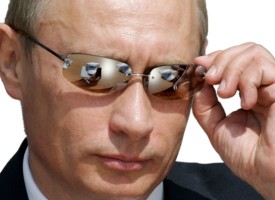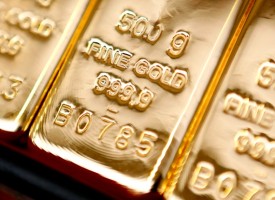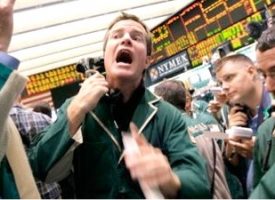Here is a fascinating chart showing at least a $370 price target for silver, plus major economic trend forecasts issued by Gerald Celente.
Silver Bull
October 26 (King World News) – Graddhy out of Sweden: This ratio chart shows how extremely undervalued silver is right now. And on lower time frame, it has broken out with silver´s huge baby bull move back in July 2020. So this chart is on the move.
Silver Target Is At Least $370
Gerald Celente: As we have long reported, and as the facts and data prove, from the Fed Banksters, to arrogant “government officials” to low-life “lawmakers” (i.e. political pieces of crap), the equity markets are a rigged game that the “insiders” get rich playing. We update these overt atrocities in this week’s Trends Journal.
Thanks to the mentally ill freaks running and ruining life on earth, the world is headed for a socioeconomic and geopolitical crisis unprecedented in modern history.
China, the world’s second-largest economy that was once thriving, is in decline. We’ve long noted that Beijing was Ground Zero in the COVID-19 War and launched draconian lockdown mandates during their Lunar New Year, the “Year of the Rat, back in January 2020… that Western “democracies” embraced.
Following China’s President Xi Jinping securing a third term as supreme ruler of the Communist Party, U.S.-listed Chinese stocks plunged to their lowest level since the Panic of ’08. Xi barely mentioned anything about the economy during the 20th Congress of the Chinese Communist Party, and yet spooked the markets, causing tens of billions of dollars in market value to evaporate on Monday.
The Nasdaq Golden Dragon China Index slumped more than 14 percent, hitting its lowest close since April 2013. According to Dow Jones Market Data, $73.4 billion in market cap vanished since Friday’s close. Recording its biggest one-day decline since the Panic of ’08, Hong Kong’s Hang Seng Tech index plunged nearly 10 percent following the news that China’s Gross Domestic Product—which was held back before the CCP meeting—rose just 3.9 percent year on year.
As we have been reporting, China expected 5.5 percent GDP growth for 2022, but Xi’s “zero-COVID” policy has been disastrous for Beijing’s economy, which is headed to a 30-year low.
Again, as with other nations, the COVID War has not only destroyed the income stream, it has sucked the joy out of life. Once a nation of travelers, the people have been forced to not only stay on the mainland, but the “zero-COVID” policy limits interstate travel as well.
Retail sales in September grew just 2.5 percent, and their real estate sector, which accounts for some 30 percent of China’s GDP, keeps sliding down. Property sales measured by floor area slumped 22 percent while new real estate construction declined nearly 40 percent from last year.
In the U.S., for the fourth month in a row, factories and service sectors continue to weaken. The purchasing manager’s index fell from 49.5 in September to 47.3 in October. A reading below 50 signals contraction.
S&P Global reported that among major companies, “The resulting degree of confidence was among the lowest in survey history,” and it was the sharpest decline since the depth of the Great Recession in 2009…
To find out which gold & copper explorer just hit significant mineralization click here or on the image below

Falling deeper into contraction, their flash services activity index fell from 49.3 in September to 46.6 in October, while the flash manufacturing PMI hit a 28-month low at 49.9 in October. Again, a reading below 50 signals negative growth.
Over in Europe, S&P Global’s composite purchasing managers index, which measures activity in both the manufacturing and services sectors, registered its fourth-consecutive month of decline, falling from 48.1 in September to 47.1 in October.
S&P Global also reports that German factories made the biggest output cuts since the early part of the COVID War, while its composite PMI also fell to its lowest level since May 2020.
The news has been horrible, and yet the Dow Jones Industrial Average is up 8.52 percent in the last month and the S&P 500 is up 5.25 percent during the timeframe.
Why? Because the rich keep getting richer.
As The Wall Street Journal headline read today, Wealthy Consumers Are Still in a Spending Boom:
“Wealthier households own most of the stock market. They may also hold the keys to a stock-market rebound—in the form of their own spending.”
Indeed, as we have reported, as the lives and livelihoods of billions across the globe were economically, spiritually, mentally, physically and emotionally devastated by the COVID War that politicians launched over two years, the 10 richest men doubled their fortunes while incomes of 99 percent of humanity fell.
TREND FORECAST:
As we noted some three weeks ago, with the midterm elections coming up in the U.S. on 8 November, when the U.S. Feds meet next Tuesday and Wednesday, they may not raise interest rates .75 percent despite inflation rising to 8.3 percent in September and the annual inflation rate for the United States at 8.2 percent.
However, while they may indeed raise interest rates .75 basis points next week, their message will be that the rise in rates has done its job, inflation is easing and so too will further interest rate hike ease.
Now our forecast, minus our having forecast this, is now the talk of the mainstream.
Today CNBC wrote:
“Taken together, the yield and major index moves are signs of investors ‘doubling down on expectations of an easier Fed,’ said Cliff Hodge, chief investment officer at Cornerstone Wealth.
“Hodge said economic data released Tuesday is also a point of hope for investors looking for the Federal Reserve to change course on interest rate hikes as the central bank tries to bat down inflation.
“‘The market is just starting to get some indication that economic data moving forward is likely to slow,’ Hodge said. ‘The knock-on effects from there, perhaps, gives the Fed a bit more breathing room.’”
And on Bloomberg yesterday, their headline was “HSBC’s Major Raises Prospect for Ultra-Low US Rate Increases.”
TREND FORECAST:
The lower U.S. interest rates fall, the deeper the now- strong U.S. dollar will sink. This will be of benefit to deeply indebted emerging markets whose currencies have dramatically declined against the dollar and whose debt is dollar based.
Lower interest rates will also benefit the U.S. government that is $31 trillion in debt and companies who will pay less interest on their loans.
The weaker dollar will also prove positive for gold whose value has been artificially depressed by a strong dollar since bullion is dollar based and is non-yielding. Yes, considering the dire socioeconomic and political realities, gold prices should be in the $2,000 per ounce range.
And minus a wild card, such as a dramatic escalation of WWIII, a nuclear explosion, etc., lower interest rates will prove positive for equities and real estate. On the downside, inflation will continue to spike as more cheap money is pumped into equities and economies.
In fact, Gregory Mannarino has identified what we have and gives his assessment of what to expect in his article, “Fed BLINKS! But Will It Last?”
LAST WEEK: STOCKS SOAR ON FRIDAY TO END THE WEEK IN POSITIVE TERRITORY
All three major stock indexes jumped last week, fueled by strong earnings reports and growing speculation that the U.S. Federal Reserve may begin to slow its pace of interest rate increases. (See “Fed Mulling a Slower Pace of Rate Increases” in this issue.)
On Friday, the Dow Jones Industrial Average rocketed up more than 748 points. The NASDAQ added almost 245 points, and the Standard & Poor’s 500 index rose just under 87 points.
The Dow and S&P posted their best weeks since June, the NASDAQ its best since July.
However, the net profit margin for S&P companies will decrease for the fifth consecutive quarter, analysts told The Wall Street Journal.
For the week, the Dow gained 3.3 percent, the NASDAQ 2.6 percent, and the S&P 2.9 percent.
The yield on the benchmark 10-year treasury note moved down on Friday to 4.212 percent, still near its high for the past 10 years. The two-year treasury note’s yield, which is more responsive to expectations about interest rates, slipped Friday to 4.489 percent. Yields fall as bond prices rise.
Spot gold inched up 0.4 percent to $1,657 by 4 p.m. U.S. EDT.
Brent crude oil for December delivery rose 1 percent to $93.50 by 5 p.m. U.S. EDT. West Texas Intermediate, the benchmark for U.S. prices, slid 1.5 percent to $85.05.
Bitcoin dropped 2.1 percent on the week to $19,147.30 at 5 p.m. U.S. EDT.
Abroad, the U.K.’s FTSE 100 index managed a gain of 1.6 percent for the week. Stocks were churned by concerns over who would replace ousted prime minister Liz Truss.
On Friday, the yield on the 10-year government bond shot up to 4.05 percent from 3.860 percent the day before. Yields rise as prices fall.
The all-Europe Stoxx 600 index grew by 1.3 percent, Japan’s Nikkei 225 eked out a 0.3-percent increase, and the South Korean KOSPI added 2.1 percent.
Chinese markets failed to follow other markets upward.
The Hong Kong Hang Seng gave up 1.6 percent, the CSI Composite dropped 2.1 percent, and the SSE Composite edged down 0.6 percent.
The markets slipped on Xi Jinping’s re-election and consolidation of power, which is more likely to mean a continuation of rolling zero-tolerance anti-COVID lockdowns as we have reported…
ALERT:
Legendary investors are buying share of a company very few people know about. To find out which company CLICK HERE OR ON THE IMAGE BELOW.
 Sponsored
Sponsored
DOW JUMPS ON RUMORS THAT FED WILL GO SOFT ON INTEREST RATES
Again, Trends Journal subscribers read “History Before it Happens®.”
For the past three weeks we have forecast that despite soaring inflation, the Federal Reserve would not keep raising interest rates at their .75 basis points rate. And while it may hike rates .75 basis points rise next Wednesday, we forecast they will announce that from this point forward, as we detail in the ECONOMIC OVERVIEW in this issue of The Trends Journal, lower rates are on the near horizon.
Thus, with low interest rates in the gamblers mindset, the Dow Jones Industrial Average was up 417.06 points yesterday, or 1.34 percent, to close the day at 31,499.62 and the benchmark S&P 500 was also up 44.59 points, or 1.19 percent, to close at 3,797.34.
The Nasdaq Composite was also up 92.90, or 0.86 percent, to 10,952.61.
Elsewhere, London’s FTSE was up 44.26 points, or 0.64 percent, to 7,013.99 and the STOXX 600 was also up 5.55, or 1.40 percent, to 401.84. In Asia, Japan’s Nikkei was up 84.32, or 0.31 percent, to 26,974.90 and South Korea’s Kospi was also up 23.04 points, or 1.04 percent, to 2,236.16. Hong Kong’s Hang Seng was down 1,030.43, or 6.36 percent, to 15,180.69. China’s Shanghai Composite shed 2.02 percent on Monday and the Shenzhen Component was down 2.05 percent.
Hong Kong’s Hang Seng was rattled by China’s Xi Jinping securing his third term as the country’s leader. Analysts see his Chinese Communist Party’s new Politburo Standing Committee as a sign that further crackdowns will occur even if it means economic hardships.
Li Qiang is seen as Xi’s Number Two. He is best known for overseeing Shanghai’s two-month lockdown during COVID-19 that crushed the economy.
The Hang Seng’s decline was its largest since November 2008.
“It appears that the leadership reshuffle spooked foreign investors to offload their Chinese investment, sparking heavy sell-offs in Hong Kong-listed Chinese equities,” Ken Cheung, chief Asian forex strategist at Mizuho bank, told CNN.
Rishi Sunak’s win to become Britain’s next prime minister was largely embraced by the European market. The pound was up against the U.S. dollar and Britain’s 10-year gilt yields were down 0.30 percent to 3.75 percent.
TREND FORECAST:
All eyes are on what the Federal Reserve’s next move is going to be after its meeting on November 1 and 2. The theory on The Street is that the Fed will weigh Thursday’s CPI data in its decision making and likely raise rates by another 75 basis points. Gerald Celente, the trend-forecaster and publisher of the Trends Journal, disagrees and said a more dovish 25 basis point increase is much more likely.
“They kept pumping this money in to artificially prop up the equity markets and the economies because of the shitheads [politicians] who lost the COVID war. So, here’s our forecast: they’re going to raise interest rates 25 basis points. And what that’s going to do…it’s going to drive up the equity markets just in time for the midterm elections.”
OIL
Brent crude was down 3 cents, or 0.03 percent, to $93.47 per barrel and West Texas Intermediate also shed 20 cents, or 0.24 percent, at $84.85 per barrel.
The Biden administration is still reeling from OPEC+’s decision to cut oil production despite overtures from Washington to Saudi Arabia. Reports indicate that the animosity runs deep between President Joe Biden and Saudi Crown Prince Mohammed bin Salman. The U.S. is considering how to retaliate against Riyadh for the public snub.
Oil prices were down after it was revealed China has been buying Russian oil at a discount, but September numbers were lower than August, indicating a slowdown. Reuters reported that Russia’s Urals crude was selling $23.92 below Brent crude’s price. There’s concerns that future COVID-19 lockdowns can further hurt the Chinese economy and its demand for oil.
TRENDPOST:
The Biden administration has failed at every turn in its response to the Ukraine War and moved China and Saudi Arabia closer to Russia. Moscow has more than enough energy supplies to fight a war through the winter months, while Ukrainians are seeking cold-weather gear.
GOLD:
Gold was trading down on Monday in the $1,645 vicinity as Treasury yields continue to rise. The 10-year note rose to 4.231 percent, which the WSJ noted was its highest closing level since 2008. The yield was trading at 4.212 percent on Friday. Yields and bond prices move in opposite directions. We have long noted that the higher bond yields increase, the more the price of gold—a non-yielding asset—can suffer.
TREND FORECAST:
We have long noted that gold prices have been depressed due to a strong dollar and monetary tightening by the Federal Reserve, which makes the precious metal less attractive for foreign investors. The benchmark 10-year Treasury note yielded 1.5 percent at the close of 2021. Gold was selling for $1,791.97 an ounce at the time.
Therefore, for the short term, the higher interest rates rise, the deeper gold will fall. But now with our forecast for a slowdown in interest rate hikes on the near horizon, gold prices will rise as the dollar weakens and inflation ticks up.
ALSO JUST RELEASED: China On The Cusp Of A Full-Blown Banking & Currency Crisis CLICK HERE.
ALSO JUST RELEASED: Bullion Banks Short Covering In The Gold & Silver Markets Continues CLICK HERE.
ALSO JUST RELEASED: Look At These 5 Stunning Charts CLICK HERE.
ALSO JUST RELEASED: This Is Very Good For Gold, Plus Future Of Rate Hikes CLICK HERE.
ALSO JUST RELEASED: Greyerz – The World Is Now On The Verge Of Another Lehman Moment CLICK HERE.
***To listen to James Turk discuss the world hurtling into a financial panic that will rival 2008 CLICK HERE OR ON THE IMAGE BELOW.
***To listen to Alasdair Macleod discuss the global collapse that will rival the Great Depression CLICK HERE OR ON THE IMAGE BELOW.
© 2022 by King World News®. All Rights Reserved. This material may not be published, broadcast, rewritten, or redistributed. However, linking directly to the articles is permitted and encouraged.









